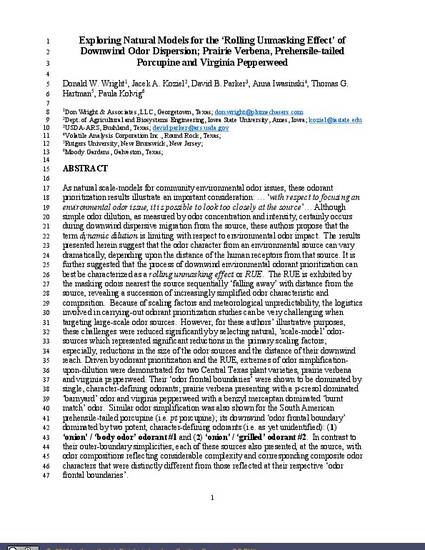
Solving environmental odor issues can be confounded by many analytical, technological, and socioeconomic factors. Considerable know-how and technologies can fail to properly identify odorants responsible for the downwind nuisance odor and mitigate it for the affected citizenry. We propose enabling solutions to environmental odor issues by utilizing troubleshooting techniques developed for the food, beverage, and consumer products industries. We showed that the downwind odorant impact-priority ranking process can be definable and relatively simple. The initial challenge is the prioritization of environmental odor character from the perspective of the impacted citizenry downwind. In this research, we aim at summarizing three natural models of the rolling unmasking effect (RUE) and discuss them more systematically in the context of the proposed downwind environmental odor prioritization approach. Regardless of the size and reach of an odor source, a simplification of odor character and composition typically develops with downwind dilution. The extreme odor simplification-upon-dilution was demonstrated for two plant varieties, prairie verbena and Virginia pepperweed. Their downwind odor frontal boundaries were dominated by single, character-defining odorants; p-cresol-dominated ‘barnyard’ odor, and benzyl mercaptan-dominated ‘burnt match’ odor, respectively. The P.T. porcupine downwind odor frontal boundary was dominated by two potent, character-defining odorants: (1) ‘onion’/‘body odor’ odorant #1 and (2) ‘onion’/‘grilled’ odorant #2. In contrast with their downwind boundary simplicities, each odor source presented considerable compositional complexity and composite character difference near the source. The proposed RUE approach’s ultimate significance is the illustration of naturally occurring phenomena that explain why some environmental odors and their sources can be challenging to identify and mitigate using the analytical only approach (focused on compound identities and concentrations). These approaches rarely move beyond comprehensive lists of compounds being emitted by the source.
Available at: http://works.bepress.com/jacek_koziel/138/

This is a pre-print of the article Wright, Donald W., Jacek A. Koziel, David B. Parker, Anna Iwasinski, Thomas G. Hartman, Paula Kolvig, and Landon Wahe. "Exploring the ‘Rolling Unmasking Effect’ of Downwind Odor Dispersion from Model Plant and Animal Sources." Preprints (2021): 2018030094. DOI: 10.20944/preprints201803.0094.v2.